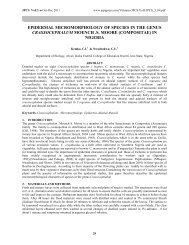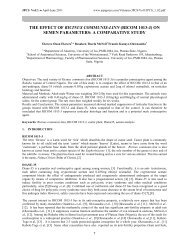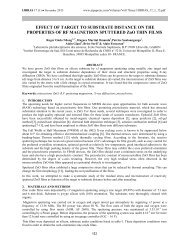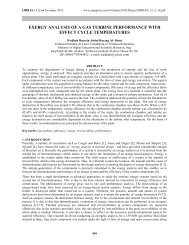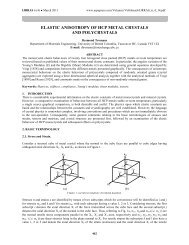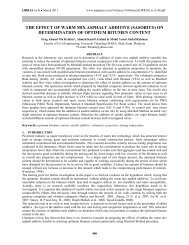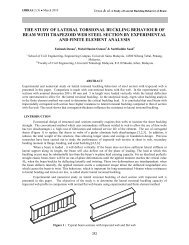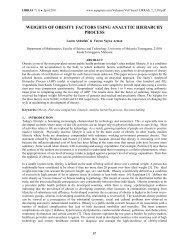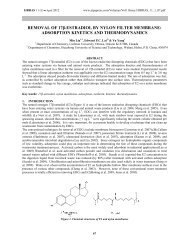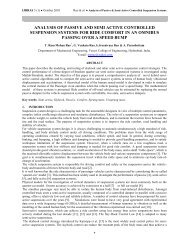Two-Dimensional Cutting Stock Management in Fabric Industries ...
Two-Dimensional Cutting Stock Management in Fabric Industries ...
Two-Dimensional Cutting Stock Management in Fabric Industries ...
You also want an ePaper? Increase the reach of your titles
YUMPU automatically turns print PDFs into web optimized ePapers that Google loves.
IJRRAS ● August 2010 Rezaei & al. ● <strong>Two</strong>-dimensional <strong>Cutt<strong>in</strong>g</strong> <strong>Stock</strong> Managment<br />
M<br />
<br />
j1<br />
w<br />
j <br />
W<br />
In the cutt<strong>in</strong>g stock problem, among all possible solutions, we are <strong>in</strong>terested <strong>in</strong> the one which corresponds to the<br />
smallest number of rolls conta<strong>in</strong><strong>in</strong>g waste.<br />
5. PROBLEM CONSTRAINTS<br />
In this problem, two constra<strong>in</strong>ts are considered:<br />
1) The cutt<strong>in</strong>g length: The maximum length of each roll is considered to be 5 meters.<br />
li ≤ 5<br />
2) Deterioration: The waste <strong>in</strong> the each step cannot be more than the previous step<br />
Wi ≥ Wi+1<br />
In this paper, as noted <strong>in</strong> the assumptions, it is assumed that the lengths of fabrics from which the patterns (pieces)<br />
are cut are unlimited. This makes the problem different from those studied so far <strong>in</strong> the literature.<br />
As mentioned previously <strong>in</strong> Section 2, general cutt<strong>in</strong>g models are not sufficient to describe the cutt<strong>in</strong>g problem,<br />
s<strong>in</strong>ce they do not <strong>in</strong>clude variables <strong>in</strong>dicat<strong>in</strong>g the location of pieces and constra<strong>in</strong>ts on their arrangements. Instead,<br />
one needs to identify different comb<strong>in</strong>ations of cutt<strong>in</strong>g styles and choose a comb<strong>in</strong>ation with m<strong>in</strong>imum waste.<br />
However, s<strong>in</strong>ce there are an extremely large number of possible cutt<strong>in</strong>g styles, it is not feasible to utilize and directly<br />
solve the aforementioned model. In this paper, <strong>in</strong> order to achieve a near-optimum solution, we have used simulated<br />
anneal<strong>in</strong>g, which is one of the most commonly-used metaheuristic algorithms.<br />
6. SOLVING USING SIMULATED ANNEALING<br />
Simulated anneal<strong>in</strong>g is a technique <strong>in</strong>spired by the natural process of anneal<strong>in</strong>g solids. The physical process of<br />
anneal<strong>in</strong>g is the cool<strong>in</strong>g of a metal sufficiently slowly so that it adopts a low-energy, crystall<strong>in</strong>e state. When the<br />
temperature of the metal is high, the particles with<strong>in</strong> the metal are able to move around, chang<strong>in</strong>g the structure of the<br />
metal, freely. As the temperature is lowered, the particles are limited <strong>in</strong> the movements they can make as many<br />
movements have a high energy cost and are <strong>in</strong>creas<strong>in</strong>gly limited to only those configurations with lower energy than<br />
the previous state. Simulated anneal<strong>in</strong>g draws <strong>in</strong>spiration from the physical process, <strong>in</strong> a computational model of the<br />
physical system [12].<br />
In the follow<strong>in</strong>g, we present the simulated anneal<strong>in</strong>g method to solve the two-dimensional cutt<strong>in</strong>g stock problem of<br />
fabric.<br />
6-1- Objective function def<strong>in</strong>ition<br />
The objective is def<strong>in</strong>ed as m<strong>in</strong>imiz<strong>in</strong>g the total waste value. The total waste value is calculated as follows:<br />
m<br />
M<strong>in</strong> Z= ∑ [ ( li * y) – ( i * S)]<br />
j=1 (5)<br />
j<br />
=<br />
1<br />
,<br />
2<br />
,000,<br />
6-2- Initial solution<br />
m<br />
An <strong>in</strong>itial solution is needed to start the SA process. The quality of this <strong>in</strong>itial solution has a significant effect on the<br />
search<strong>in</strong>g process of SA. In other words, if the <strong>in</strong>itial solution corresponds to a good quality of the objective<br />
function, the process to achieve an optimum or near optimum solution of the problem may have a better<br />
performance, and <strong>in</strong> many cases, a higher speed.<br />
To f<strong>in</strong>d a good <strong>in</strong>itial solution, we started to layout the parts from the reference po<strong>in</strong>t (left side and bottom angle of<br />
each rectangular <strong>in</strong> each fabric).<br />
246<br />
(4)



